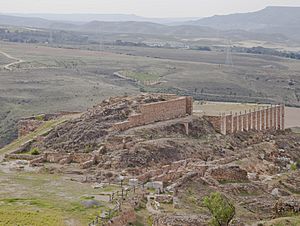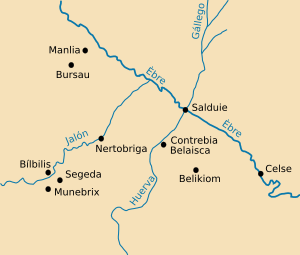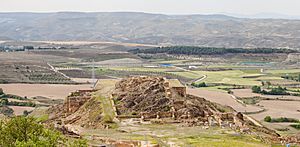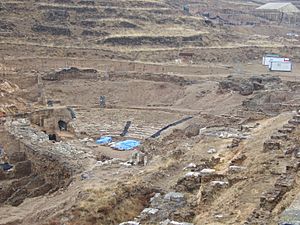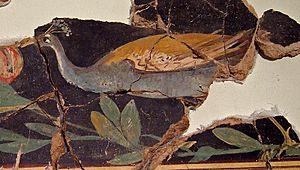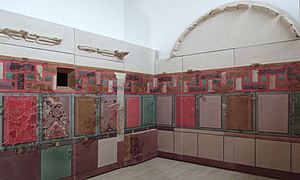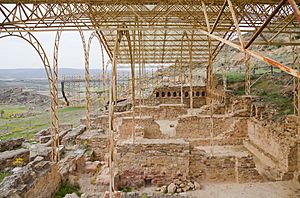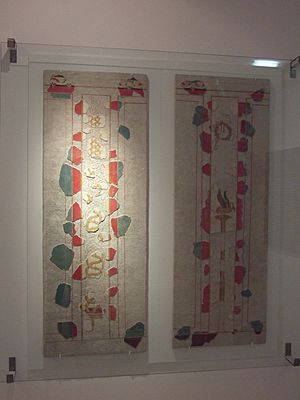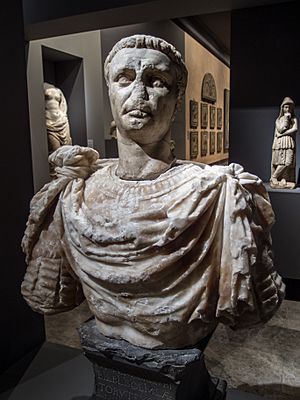Bilbilis facts for kids
Augusta Bilbilis was an ancient city built by the Romans in a part of Spain called Hispania Tarraconensis. It was the hometown of a famous poet named Martial, who was born around 40 AD. Today, the modern town of Calatayud is located very close to where this Roman city once stood.
Recent digs have uncovered many old buildings and structures. These remains are still visible today and show how important and rich the city's past was.
Contents
History of Bilbilis
Early Times and Origins
The first settlement at Bilbilis belonged to the Celtiberians. These were local tribes who lived in Spain before the Romans arrived. Their town was built on high hills called Cerro de Bambola and San Paterno. It was located north of Segeda and about 60 kilometers southwest of the Roman city of Caesaraugusta (which is now Zaragoza).
Bilbilis was well-known for its metalworking, especially for making weapons and tools.
The people living here were part of a Celtic tribe called the Lusones. Bilbilis was their main city. They even made their own coins! These coins often showed a man's head on one side and a horseman with a spear on the other. Some of these old coins, from the late 2nd to early 1st century BC, are now in the British Museum.
The Romans first met the Lusones around the 2nd century BC. A Roman leader named Quintus Fulvius Flaccus traveled into their land, known as Celtiberia. But it took a while for Roman culture to truly spread. By the 1st century BC, Roman ways of life, language, and customs slowly started to mix with the local cultures. People began to adopt Roman ideas while still keeping some of their own traditions.
How the City Grew
After a period of peace in Spain and the death of Julius Caesar, Emperor Augustus made many changes to how the Roman Empire was run. Bilbilis became very important during this time. A major Roman road, connecting Emerita Augusta to Caesaraugusta, passed nearby and helped Bilbilis grow.
The city was given a special status called Municipium. This meant it became Augusta Bilbilis and its people gained many rights under Roman law. All its residents became Roman citizens. During Augustus's rule, many grand public buildings and spaces were built in the city.
Bilbilis also minted its own coins with "Augusta Bilbilis" written on them. These coins sometimes showed the name of the local governor. Ten types of coins were made under Augustus, four under Tiberius, and one under Caligula.
A powerful Roman official named Sejanus was a supporter of Bilbilis. However, he later lost his power and was seen as an enemy of the state. Because of this, his name was removed from statues, monuments, and even coins. Many coins with his name were filed down or stamped over to erase his memory. A few rare coins still show his name.
The famous poet Martial was born in Bilbilis between 38 and 41 AD. He often wrote about his home region in his poems. For example, he praised the warm, sulfur springs of Aquae Bilbilitanorum. These springs, about 24 kilometers west of the city, are still used as spas today. Martial moved to Rome when he was 24 and lived there for over 34 years. He then returned to Bilbilis for three years before going back to Rome, where he published his last book and died in 103 AD.
The city was at its busiest and most important in the 1st century AD. However, it started to decline quickly in the 2nd century AD. By the 3rd century, about half of the city was empty.
The City and Its Buildings
The city of Bilbilis was built in a Roman style, but it was a challenging project. The land was very hilly, so the city had to be built on different levels, like terraces. This meant the streets were steep, with ramps and twisting paths to connect the different parts of the city. This was different from the usual straight grid pattern of Roman towns.
The new buildings helped Bilbilis become the main center for politics, business, and social life in the area. To serve these purposes, the Romans built a large complex. It included a main square (the forum), a temple, a basilica (a public building for meetings), a curia (for government), and a theatre. They also built baths and a clever water system called a nymphaeum. This system used tanks to bring a constant supply of water to the city, adapting to the hilly land.
The central part of the city was home to the most important buildings, like the forum and the theatre. Two main roads led to this area from the city gates. One gate was near the Jalón River, and the other was close to the theatre.
Many beautiful wall paintings, called frescoes, from the baths and private homes (called domus) can be seen today. They are displayed in the Museum of Calatayud.
The Forum
The forum was the main public square in Bilbilis. It was almost square-shaped and located in front of the temple, on the highest part of the city. It was decorated with marble and statues. The forum was surrounded by covered walkways, a basilica, a curia, and an underground passage (crypto-porticus).
The forum was finished during the time of Emperor Tiberius. Some changes were made to it later, during the rule of Emperor Trajan.
The Theatre
The theatre was designed to be connected to the forum through gates and corridors. It had two levels with fancy Corinthian columns. The builders cleverly used the natural slope of the hill to help create its shape.
The theatre was likely used for local shows and performances. It was quite large, able to hold about 4,500 people. This was more than enough for the city's population, which was estimated to be around 3,500.
The Baths
The Roman baths were built on a hillside. They were surrounded by several large tanks that supplied them with water. The bath complex included rooms with heated pools, like the caldarium, and latrines (toilets). Many rooms were decorated with high-quality frescoes. These paintings were probably made by a team of skilled Italian artists who traveled around the Ebro valley.
Exhibits in the Museum of Calatayud
A lot of the items in the Museum of Calatayud come from the archaeological site of Bilbilis. These include collections of wall paintings, coins from the city's own mint, and sculptures. There are also portraits of the Roman imperial family, especially from the Julio-Claudian period, found near the theatre.
One very interesting piece is a marble bust of Emperor Augustus, found in 2009. It shows him with his head covered, which was a special official portrait. This is one of the few examples of this type of portrait found in Spain.
See also
 In Spanish: Bílbilis para niños
In Spanish: Bílbilis para niños


